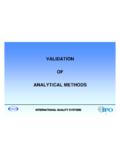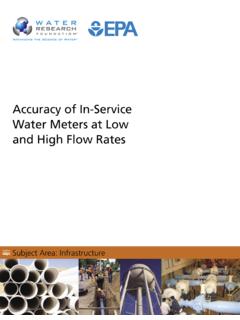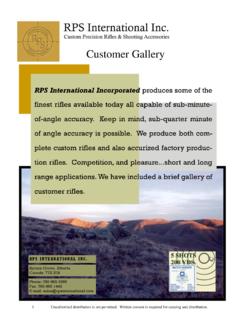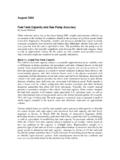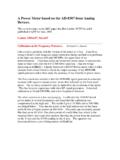Transcription of INTERNATIONAL RESEARCH JOURNAL OF PHARMACY
1 Anisuzzaman Sharif Md et al. IRJP 2012, 3 (7) Page 144 INTERNATIONAL RESEARCH JOURNAL OF PHARMACY ISSN 2230 8407 RESEARCH Article METHOD VALIDATION FOR THE DETERMINATION OF WATER CONTENT OF METERED DOSE INHALER BY KARL FISCHER COULOMETER Momin Mohammad Abdul Motalib1, Afrose Afrina1, Khan Mohammad Salahuddin1, Mashud 2, Anisuzzaman Sharif * 1 Department of PHARMACY , Jahangirnagar University, Savar, Dhaka, Bangladesh 2 Sir Salimullah Medical College, Dhaka, Bangladesh Article Received on: 12/04/12 Revised on: 20/05/12 Approved for publication: 16/06/12 *E-mail: ABSTRACT This study aimed to validation of water content determination method of inhaler by Karl Fischer Coulometer to outline a simple procedure. The system suitability test was performed by injecting standard solution ( water standard).The average % recovery was found 99% which is within the acceptance limit of 95% to 105%.
2 From the specificity study, it was observed that there was no response in case of blank (without sample or standard) measurement, and the spike sample (with standard) showed positive response. In the linearity study the squared correlation coefficient was found to be , which indicated that the method was linear. It was observed that %RSD of system precision, repeatability, and intermediate precision were 3%, 6% and 7% respectively which was within the acceptance limit (5% for system precision and 10% for repeatability and intermediate precision).The result of accuracy in terms of average % recovery of water was 99% with average %RSD 1% and 95% confidence interval was to The method was found to be robust for changing titrant source, titrant volume and rotation of stirrer. The titrant was found to be stable up to 24 hours.
3 So, it can be a good alternative to existing methods for water content determination. KEYWORDS: Inhaler, Karl Fischer coulometer, water content, validation. INTRODUCTION Method validation is the process of testing a measurement procedure to assess its performance and to make certain that performance is acceptable. Validation or revalidation of method is essential before their introduction into routine The INTERNATIONAL Conference on Harmonization (ICH) has developed a text on the validation of analytical Guidelines on submitting samples and analytical data for methods validation also proposed by the United States Food and Drug The United States Pharmacopoeia (USP) has published specific guidelines for method validation for compound Metered-dose inhaler (MDI) delivers a specific amount of medication (bronchodilator, corticosteroid or a combination of both) to the lungs, in the form of a short burst of aerosolized medicine that is inhaled by the patient.
4 It is the most commonly used drug delivery system for treating asthma, chronic obstructive pulmonary disease (COPD) and other respiratory In pressurized metered-dose asthma inhalers Chlorofluorocarbons (CFCs) have historically served as the propellants of choice, but concern has been raised in recent decades regarding their damaging effect on the ozone layer. Among the alternative propellants being considered is Hydrofluoro alkane (HFA) in asthma According to Guidance for Metered Dose Inhaler (MDI) and Dry Powder Inhaler (DPI) drug products, ethanol is added to HFAs to increase the solubility of excipients such as surfactants - oleic acid. While water is quite insoluble in pure HFAs, the presence of ethanol allows greater solubility. The MDI formulation composition will have a direct effect on the degree or extent of agglomeration or suspendibility of the drug substance particles.
5 Preferential interaction of the suspended drug substance with the various internal container and closure system components ( , adherence of the drug substance to the walls of the container or valve components) may also contribute to a non-homogeneous distribution of drug substance. The above mentioned phenomena may be exacerbated with time, can contribute to inconsistent medication dose delivery and particle size distribution. Study showed that the drug-free MDIs produced lower electrostatic charges than the commercial medicated ones .The charges of both HFAs shifted towards neutrality or positive polarity as the water content increased. The spiked water would increase the electrical conductivity and/or decreased the electro negativity of the liquid propellant surface. The mean number of elementary charges per droplet decreased with decreasing droplet According to Karl Fischer-application bulletin 137/3 the reagent and solvent should be in the same liquid during coulometric water determination.
6 The reagent is released by the induction of an electrical current. The amount of current required convert the water is the determinant of the amount of moisture. Coulometric water determination is primarily used for the determination of small amounts of The objective of present study is to outline a simple procedure for the water content determination method for commercially available salbutamol sulfate metered dose inhaler. MATERIALS AND METHODS Chemicals, Reagents & Standards Hydranal and methanol solution for Karl Fischer coulometer were from Sigma Aldrich, Germany and Merck KGaA, Germany respectively. water standard from Merck KGaA, Germany was used. Inhaler samples were collected from the local market of Bangladesh. Instruments, Equipments & Apparatus A Karl Fischer Coulometer from Metrohm Ltd., Switzerland, analytical four digit balance from Mettler, Switzerland, and syringe with needle from JMI Bangla Co.
7 Ltd, Bangladesh were used. Anisuzzaman Sharif Md et al. IRJP 2012, 3 (7) Page 145 Methods System Suitability Water standard vial was broken to open. Approximately 1 ml of standard solution was filled in the syringe using the needle. Syringe was rinsed by turning it round and holding the needle point up to expel the entire contents (air and standard solution). This moistens the whole inner surface of the syringe. The syringe was filled with the entire remaining contents of the vial, with no aspiration or air. The needles were wiped and weight of the syringe was tarred on the balance. After starting the KF coulometer approximately ml of the standard solution with one stroke was injected directly under the surface of the KF solution. The syringe was removed from the KF solution and re-weighed.
8 The total water content given by the KF (C) was recorded. Above steps were repeated by injecting approximately ml. and ml. Percent recovery for the three determinations were calculated Sample analysis The pMDI unit was shaken and the stem was attached to the adaptor in the titration cell. After performing all actuations weight of the inhaler was entered in the KF. pMDI unit was disconnected from the needle adaptor. The unit was reweighed to record weight difference. Water content determined automatically by the KF (C) was recorded. Above steps were repeated 3 times per unit. Validation The coulometric method was validated by determining its system suitability, specificity, linearity, precision, accuracy, robustness and stability study. The system was deemed suitable if the % recovery was 95-105%.
9 Specificity demonstrated that for blank there will be no response but for spike sample it should have positive response. For the method to be linear the R2 value should be close to case of system precision the %RSD should be not more than 5% and method precision and intermediate precision should be within 10%.In accuracy study the recovery obtained did not differ from the real value in more than 5%. The method should be robust through the change of titrant (different source), titrant volume and rotation of stirrer. RESULTS AND DISCUSSION System suitability testing System suitability testing is an integral part of analytical procedures. The tests are based on the concept that the equipment, electronics, analytical operation and samples to be analyzed constitute an integral system that can be evaluated as such.
10 Table-1 shows the system suitability data. For system suitability three different concentrations ( , and ) of water standard was used and % recovery was evaluated. Table 1 represents that the % recovery for three different determinations is within 95-105%. So the system was suitable for further analysis. Specificity Specificity of an analytical method is its ability to assess unequivocally the analyte in the Presence of components that may be expected to be present. Lack of specificity of an individual analytical procedure may be compensated by other supporting analytical Table-2 shows the specificity data. From this study it was observed that, in case of blank there is no response but for standard measurement it shows positive response. So the method is very specific for determination of water. Linearity The linearity of an analytical method is its ability to elicit test results directly proportional to the concentration of the analyte in samples within given range.







